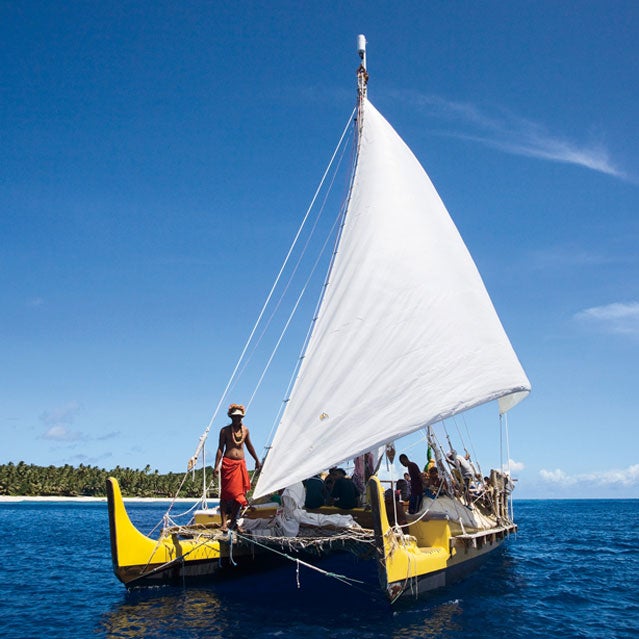It’s 11 P.M., and I’ve just crawled from my bunk for my midnight to 6 A.M. watch. I arrive on deck to hear Sesario order everyone to drop the jib. He has made the decision to ride out a fierce storm with our sails down, what sailors call running under bare poles.
Running the jib
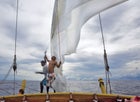 Running the jib
Running the jibSesario at his navigating post
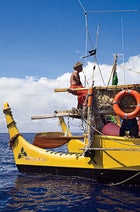 Sesario at his navigating post
Sesario at his navigating postTurtle hunting
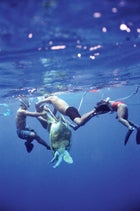 Turtle hunting
Turtle huntingIsland life
 Island life
Island lifeCaptain Sesario Sewralur
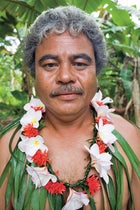 Captain Sesario Sewralur
Captain Sesario SewralurBalancing on a narrow plank in driving rain, two crew members struggle to gather the galloping jib as our boat rises and plummets down 15-foot waves. There are no winches and no roller to furl up the sail onto the headstay—only ropes, cleats, and brute strength. As a matter of pride, none of the crew wear life jackets. It looks as if the sail is going to get away and the two men will be flung out to sea, but somehow they wrestle it in and tie it off.
Tired, wet, and cold, they climb into their hammocks in the tomblike hulls of the Alingano Maisu, our 56-foot catamaran, a modern version of a traditional Hawaiian single-mast, double-hull sailing canoe. There is nothing left to do but rest and hope that our vessel holds up against the howling winds.
We’re in the Federated States of Micronesia, in the Caroline Islands, where people say that palu, local master navigators, have magic. They ply the waters of the Pacific in traditional hand-carved sailing canoes made of mahogany and breadfruit wood and talk to the clouds, currents, seabirds, waves, and, legend has it, ocean spirits, relying largely on the stars as their guide. The Maisu has no GPS unit to plot a course, no radar to help with navigational hazards, no fax machine with daily weather updates, and no satellite uplink for Internet access. I don’t know if our captain, Sesario Sewralur, a palu and the son of the great Mau Piailug, Micronesia’s most famous navigator, possesses magic or not, but if he does I want him to use it.
It’s our sixth night at sea, and malevolent black thunderheads have closed in around us from the north and the east. Earlier in the night, Tony Piailug, Sesario’s brother, did his best to tame the gathering storm. He stood at the rail whispering, chanting, and using his hand as a blade to separate the clouds, summoning whatever powers he’d inherited from his father. But minutes later, a wind began to blow with a predatory moan.
Kurt Ngiraked, one of Sesario’s two navigators in training, and I are now alone on deck. Kurt grew up on an island north of the Republic of Palau. He is a huge, craggy-faced, dark-skinned man who rarely speaks and reminds me of the Chief in Ken Kesey’s One Flew Over the Cuckoo’s Nest. With every star obscured by dark clouds, Sesario has instructed us to hold a compass course. My job is to shine the flashlight so that Kurt, using the 30-foot steering paddle, can point us due east.
The blinding rain beats down on us and finds its way under my rain gear. By 3 A.M., the wind has become Homer’s “yelping horror.” After four hours, its freight-train roar has worn me down physically and psychologically. I am soaked and freezing, hanging on to the rail, fearful that I will be blown off the canoe hundreds of miles from help. Kurt, holding the steering paddle firmly, struggles to keep the Maisu parallel with the cresting waves, to prevent them from rolling us.
At one point, Sesario opens the flap to his compartment. I crawl over to him. When we left Palau, he put me in charge of the emergency locator beacon without giving me any instructions about when to use it. “Should I press Help?” I yell to him. He cups his hand to his ear, and I yell again. “Not yet,” he answers. Then he zips his canvas cover and disappears.
THAT’S THE FIRST time I wonder about the wisdom of our journey. We are sailing across the Pacific via a route Sesario has never taken before, re-creating the exploratory journeys of his ancestors and the ocean’s pioneers.
Our goal is to sail a straight-line distance of 800 miles from Koror, an island in Palau, east across the open ocean and through the Caroline Islands, a region of iridescent lagoons, traditional cultures, and untouched white-sand beaches. After a stop on Woleai Atoll, we will travel nearly 200 miles east to Sesario’s home, the tiny island of Satawal. Under different circumstances, Sesario wouldn’t use a compass. When the Carolinians set off on an open-water adventure, they abide by no schedule. But we are on a quasi-Western timeline, attempting to reach Satawal in 12 days, by mid-April.
This is normally the season of stable winds and what the Carolinians call voyaging skies, when the islanders return to the ocean to travel up and down the island chain, fishing and hunting sea turtles. It is also a time of wanderlust, when the wind takes possession of young men’s souls. For the Carolinian people, confined to tiny spits of coral, the ocean has always been their grocery and their highway. But it is also their wilderness, a proving ground where young men, like those on Sesario’s crew, test themselves.
Stretching 1,800 miles from west to east, the Caroline chain is made up of approximately 600 islands, of which about 80 are inhabited. Roughly at its geographic center, Satawal is considered by many to be the heart of open-ocean wayfinding, or star navigation, in which sailors follow a course based on the rising and setting positions of 16 constellations or individual stars. Lying south of Magellan’s 1521 course through Micronesia and the trade routes that followed, Satawal escaped European influence and the magnetic pull of the compass. Later, as the modern world encroached, its navigators kept the tradition of star navigation intact. They remained proud outer islanders, re metau, people of the sea.
Satawal has produced no greater star navigator than Sesario’s father, Mau Piailug. Mau was six years old when his grandfather began teaching him about the constellations by arranging 32 pieces of coral in a circle to represent the points of the star compass, a demonstration called unfolding the map. Then he explained to Mau how the stars rose in the sky and traveled from east to west. Mau memorized the course of each and eventually learned the paths of more than a hundred.
Papa Mau, as he is known on Satawal, was recruited in 1976 by the nascent Honolulu-based Polynesian Voyaging Society to teach its members celestial navigation, an art the Hawaiians had lost five centuries before. Mau guided them in the ��ǰ�ܱ���‘a, a replica of a traditional eastern Polynesian voyaging canoe, on an exhausting 2,500-mile trip from Hawaii to Tahiti, retracing one of the historic migration routes of Oceania from a time when blue-water sailors in vessels bigger and faster than Captain Cook’s Endeavour explored the unknown Pacific. The ��ǰ�ܱ���‘a—from the Hawaiian name for Arcturus, the star that once led Polynesian canoes north to Hawaii—arrived in Tahiti 34 days later. Seventeen thousand islanders turned out for the reception. Since then, many more people in the Hawaiian Islands have embraced the traditional ways of sailing, and in 2009, the U.S. Congress earmarked $238,000 to the Polynesian Voyaging Society to continue its efforts to preserve them.
Originally, I’d hoped that Mau or Uurupa, his brother, also an accomplished navigator, would lead our voyage. I’d met 78-year-old Uurupa on a scouting trip to Saipan in 2009, after he’d led a small fleet of sailing canoes 450 miles north from Satawal. But Uurupa’s health was failing, and Mau had died in 2010 after a long battle with diabetes.
Mau’s legacy now lies in the hands of his 42-year-old son, our captain. Sesario has five children, a charming wife, and an easy way about him—if there is drinking, dancing, and singing, he’ll likely be in the middle of it. When not on the Maisu or teaching a navigation course at , he does maintenance work for the school.
“When I was young,” Sesario says, “my father wanted to teach me navigation, but I was not interested. In my twenties, I was doing traditional dancing for tourists at high-priced hotels in Saipan. When I got sick of that, I was ready to learn the old ways. Now my goal is to keep our culture alive.”
For our journey, Sesario has put together a crew of 12, including photographer Philipp Engelhorn and me. Serving as deckhands are Noah, a young man from the island of Ifalik; Calson, a sweet-natured 20-year-old kid from Palau who has never been at sea; and Peter, David, and Mianu, young men from Satawal who dream of becoming voyagers. Kurt Ngiraked and Frank Pedro are Sesario’s apprentice navigators, who must study for more than 20 years before being allowed to take a solo voyage. Finally, there is Phillip Sablan, a sculptor and tattoo artist from Guam who is transporting a headstone he carved for Mau’s grave; Kazuyoh Hayashi, a Japanese writer who has been visiting Satawal for seven years and was adopted by Mau’s eldest daughter, who is dying of cancer; and Tony, Sesario’s elder brother, whose resemblance to his father is remarkable.
Although Tony is an accomplished navigator, sailor, fisherman, and canoe builder, it is clear who our leader is. Sesario has dozens of voyages to his credit, including a 45-day, 3,500-mile journey from Hawaii to Satawal in 2007. Like his father, Sesario has undergone the sacred pwo ceremony, a distinction that places him among an exclusive class of star navigators whose ancestors pioneered the remote islands and atolls of Micronesia.
Thankfully, he employs this knowledge the morning after the storm.
“Big one last night,” he says, sitting on a bucket near the rail.
“Yeah, scary,” I say, although what I want to say is “Where were you?” But I keep my mouth shut. On land, navigators pay respect to chiefs, elders, and contemporaries from higher clans, but at sea they are afforded godlike status. The Carolinians also have a superstition about disharmony aboard ship. Dissent can send a crew to a watery grave every bit as fast as high winds and waves.
“The weather is changing,” Sesario says, scanning the sky, which is now streaked with fragile strands of light. “Things are not the same as they once were.”
Sesario employs a sophisticated form of dead reckoning using a variety of natural signs—including star paths, reference islands, the shapes and colors of clouds, ocean swells, the sun, the flight paths of birds, and the salinity of the water—to determine his position on the ocean. His ability to locate himself at sea is born of intimacy and skills unknown to modern sailors.
It takes Sesario the better part of the morning to figure out where we are. By his estimation—and the presence of a frigate bird, whose range can reach up to 75 miles from land—we are 50 to 60 miles south of Woleai. This is considerably farther south than he’d hoped, so we are changing course. Instead of heading for Woleai, we will aim for the small island of Ifalik.
ALTHOUGH THE MAISU looks huge, its size is misleading. Its deck space is only half the length of its 56-foot hulls and is crowded with coiled ropes, anchors, coconuts, bananas, bunches of betel nut leaves (which the crew chews incessantly), and water jugs. Each person on board has a six-hour shift, with four people to a crew, pending the weather. During a shift, we adjust the mainsail and execute an occasional tack, but mostly we fish, drink instant coffee to stay awake, pump out the pontoons, which collect water, and sit on deck listening to crew members’ stories.
Tony entertains us for hours with jokes and memories of growing up on Satawal. “When I was a little boy,” he says, “I would cover myself with coconuts or a palm mat and sneak away in the bottom of Mau’s sailing canoe. They wouldn’t find me until we were out at sea. I’d go with Mau whenever I could. At school the teachers called me Absent because I was rarely there. The women scolded Mau, telling him I was too young to voyage.”
He told us about the tradition of sending sailors off with gifts to accompany them into the next world if they perished. Years ago, death was common on long voyages. (Now fewer long voyages are taken, and not as many Carolinians die, but open-ocean sailing is still very dangerous.) Tony also told us about the bizarre display of love and relief with which Satawalese women welcome home returning voyagers, holding them underwater. “You will see,” Tony says. “You cannot escape the women. There are too many. When they catch you, they will hold you under until you almost drown.”
Our first six days at sea were relatively uneventful. There were no islands or birds to break the endless horizon of ocean; only fierce evening storms shook up the monotony. Sesario seemed confounded by the ferocity of the weather and was often quiet. Sometimes he’d watch the sky for hours, stopping only to give occasional instructions to his crew.
On the morning of the seventh day, I ask Sesario how we will reach Ifalik. Using his index finger to point, he shows me. “We will begin by following Maragar,” he says, or Pleiades. “When it reaches here—” he pauses, looking up at the sky—“we will steer by the next rising star.”
To get from point A to point B, a navigator chooses a reference island, point C, and divides the journey into stages, or etak. Island C might be close or 100 miles in the distance, but seeing it is not important because he knows the star it lies beneath. As he proceeds, it will fall under a succession of navigating stars depending upon the length of the trip. In his mental picture, the sailing canoe is a stationary object in a moving sea beneath fixed star points. The islands, too, are said to move. When a navigator reaches a point where the star under which the reference island lies is off the vessel’s stern, he knows that he has almost arrived. (To stay on course during the day, a navigator tracks the path of the sun and uses his knowledge of ocean swells, which also guide boats on cloudy nights.)
That night I wake for my graveyard shift at 11:30. The stars are spread thick across a coal black sky. It’s easy to see why the Carolinians still make their way across the Pacific with their heads craned toward the heavens. Their ancestors were the descendants of seafarers who had abandoned their homes in the southwestern Pacific to explore and colonize the central Pacific. Until recently, many archaeologists called all of their pioneering ancestors the Lapita people and thought that the human settlement of the central and eastern Pacific had been part of an ancient migration from China, Taiwan, and the islands of Southeast Asia some 6,000 years ago. John Terrell, a curator of Pacific anthropology at Chicago’s Field Museum of Natural History, notes, however, that “people had already been sailing from island to island in the southwestern Pacific for more than 40,000 years, and sailors had already become well accustomed to finding new places to call home on previously uninhabited islands.” One thing most archaeologists today agree on is that somewhere around 1000 B.C., voyagers intent on finding new landfalls grew bold and reached the Fiji islands in the central Pacific, covering hundreds of miles of open ocean. By the time of Christ, people were making bluewater jumps into the void of the eastern Pacific using outrigger canoes. A thousand years later, they were carving and standing up huge statues on Easter Island, while others pressed east and north to discover Hawaii.
It is easy, too, to dismiss the skepticism of archaeologists like Atholl Anderson, who believes that, without the aid of sextant, map, or telescope, the people of the Pacific did not have the navigational skills to make deliberate migrations against prevailing winds. Professor of prehistory at the Australian National University, Anderson suggests that, driven out of their homes by war, environmental overexploitation, and the hope of finding a new place to sustain them, they arrived accidentally or opportunistically, drifting with currents or blown by El Niño winds that, for brief periods, reversed the east-west course of the trades. Others, including Geoffrey Irwin, a professor of archaeology at the University of Auckland, don’t deny that possibility but argue that these people were more often brave pioneers with, he’s said, “sophisticated traditions of seafaring.” Mau’s 1976 journey—the longest open-water voyage in more than 600 years—proved to many that these ancient mariners were capable of long-distance exploration. Even so, some archaeologists and historians continue to doubt their ability to mount long, intentional voyages.
At midnight, Noah, who hasn’t been back to Ifalik since he left in 2007, is tending the steering paddle and singing love songs. David adds the harmony. When I ask Noah why he has chosen such sad songs, he explains that he has just broken up with his longtime girlfriend. He is quiet for a moment and then brightens. “But there are many women. Just like the stars.”
The night is beautiful and calm, and morning comes slowly. A pod of dolphins and a flock of terns greet us, but what amazes me most is the ocean. Barely a wave breaks its surface.
Shortly after sunrise, Sesario and Tony try to locate Ifalik. Tony explains that over land, clouds move slowly. Often, too, they are V-shaped and greenish in color. Birds and driftwood become more prevalent. The rest of us are standing on tiptoe trying to catch sight of the island. Everybody’s money is on Kurt. The crew says that the huge Palauan has the eyes of a fish eagle and can see forever. Carolinians say that experienced navigators can detect subtle changes—larger swells and waves caused by landforms—in their testicles.
Sure enough, Kurt spots the island at 8 A.M. A half-hour later, I see Ifalik’s faint outline.
IFALIK’S VILLAGERS, paddling brightly hued dugouts and maneuvering small single-hull sailing canoes painted red and black to mimic the colors of the male frigate bird, greet us. Curious boys tie up to the Maisu, climb aboard, and shyly examine us from a distance.
Sesario goes ashore first to present Ifalik’s chief with a gift. At noon we get word that we can join him. Cradling my drybag, I lower my weight into a dugout, nearly swamping it. The Ifalik boys laugh so hard they fall out of their canoes. With the water lapping at our gunwales, my helmsman, Jesse, strains to keep the dugout moving forward. He grunts and then says, “You bik man, Jems.”
Later, we’re eating in the village when a sailing canoe glides into the shallow water of the lagoon. The men have been out fishing since before dawn. Children swarm the boat, whooping and shouting. The fishermen have returned with a hull full of tuna.
“We can’t rely on the fish anymore,” one villager tells me as I help haul his catch from the canoe. Islanders have long been committed to sustainability; chiefs will shut down certain types of fishing if they feel the villagers are overharvesting. “Every year, because of unregistered foreign purse seiners and longliners fishing illegally, it gets harder,” the villager continues. “They take as much as they can and then flee before the authorities can catch them.”
After the fish have been brought ashore, the fishermen retire to the canoe house for a brief rest before cleaning the tuna. One of the men sits down next to me and introduces himself as Henry. As a young man, Henry left the island to work on fishing boats in South America. He is back now and happy to be home.
After I express surprise that the villagers still use sailing canoes, he explains that the island’s chief is intent on preserving his people’s self-sufficiency. “Once, the canoe was a necessity for trading, fishing, turtle hunting, and finding a mate outside of one’s clan, but many of the islands have switched to powerboats,” Henry says. The problem, he continues, is that when there’s no gas, no one can go anywhere. With just one government ship serving the Carolines, boats are often left stranded on the beach for long -periods of time. Although Ifalik has three boats with 40-horsepower engines, the chief has declared that they can be used only for health emergencies (the closest airstrip is on Falalop Island in Ulithi Atoll, more than 500 miles northwest) or, if the wind does not cooperate, to help fishermen transport their catch to the island before it spoils.
“The simple life is good,” Henry says. Then he adds with obvious pride, “We sail, also, because we are men.”
“TURTLES,” MIANU SAYS excitedly. “We will hunt turtles!”
The next morning, the ninth day of our trip, we are leaving Ifalik when Sesario announces another change to our itinerary. Because of strong southeast winds, we will go on a turtle hunt before heading for Satawal.
For hundreds of years, spring has been the season when Carolinians hunt green and hawksbill sea turtles, which after their long migratory journeys often come ashore to mate and lay their eggs on the uninhabited islands of the Caroline chain. Roughly coinciding with our winter, lefung is a time of hunger, three months of sparseness when there are few fish, little taro, and no breadfruit. The outer islanders grow thin and look forward to the time when meat is again plentiful, often celebrating with an island-wide feast. Steeped in centuries-old conservation practices, the islanders use traditional hunting methods, rarely capturing more than ten to twenty turtles or taking eggs. Although organizations such as the International Union for Conservation of Nature go to great lengths to protect the now endangered green and hawksbill turtles, and although turtle hunting and trading are illegal in many countries, most Micronesians abide by the laws in their states—laws that include closed seasons and minimum sizes for turtles to be caught. A traditional hunt is often regulated by an island’s chief, who makes decisions about when and how many turtles can be captured based on sustainability and other factors. While turtle populations in Micronesia are decreasing, some scientists say the larger culprits are modern ships from the main islands that enable poachers to take hundreds of turtles each year, not outer islanders’ practices.
It takes us three days of open-ocean sailing from Ifalik to find the turtle island. Two days out, we’re sitting under the scorching equatorial sun, fishing and praying for clouds or a rain shower, while Tony, Sesario, Cal, and David, impervious to the heat, play spades. The sun is riding along the surface of the ocean when one of our lines sings out. Tony jumps up, seizes the rod, and, after a short fight, pulls in a small rainbow-colored mahi-mahi. He bites it behind the eyes to kill it and then cuts open its belly and pops the heart and liver into his mouth. Frank digs his fingers into the fish, scoops up the roe, and slurps it down. Then Tony expertly fillets it and cuts it into bite-size chunks. Next he mixes a marinade of wasabi, soy sauce, and black pepper. Minutes later, we are eating the finest, freshest sashimi the Pacific has to offer.
At dawn the next morning, Sesario points to a kettle of birds, brilliant blotches of white against an electric blue sky. “The island is there,” he says. Twenty minutes later, Kurt sights it. As we approach, Frank sees turtles swimming gracefully just below the surface of the water. Everybody is chattering now, “They’re here—the turtles are here!”
We anchor outside the reef. Frank and -David grab their spearguns while Noah, Peter, and new crew member Norman, who joined us in Ifalik, dive in and swim for shore. Before looking for turtles, they beeline for a grove of coconut palms to make an offering to the -island spirit. Then I see them sprint across the beach in the direction of a large piece of driftwood. As they near it, the wood moves. They are on it in seconds, flipping the turtle over onto its back.
By the time I get inside the reef, Noah, Peter, and Norman have a green sea turtle trapped in a small, shallow bay. As they close in on it, it surfaces, dives, and surfaces again. The turtle looks frantic, its big eyes bulging. David yells for me to shut off its escape route. I wade in reluctantly just as it dives and propels itself into deeper water.
A few minutes later, Peter is wrestl-ing a third turtle, a 200-pound male hawksbill, which is lying upside down and gasping for air. Norman hustles down the beach to help. By the time he grabs hold, the turtle is in three feet of water. Peter rides it, and Norman, who is built like a noseguard, pushes with all his might and turns the turtle onto its back. Then he and Peter tug it to shore.
On the beach, Tony has pried open the lower portion of a small female’s shell and has extracted 20 feet of intestines, which he stretches out in the shallow water. Amazingly, the turtle is still blinking and breathing. I turn my head. The sheer brutality of the hunt is hard to witness.
When Tony finishes stripping and cleaning the intestines, he builds a fire on the turtle’s shell and roasts them. When they’re done, he cuts them into bite-size pieces and scoops them up in his hand. “Here, Jems,” he says. The intestines are rich and chewy, like grilled calamari soaked in a vat of butter.
Having bound and tied the turtles’ flippers, Tony and the boys are ready to float them out to the Maisu. “Watch out for sharks,” Tony warns. “They will smell the blood.” A minute later, he yells, “Sharks!” I feel something large bump my leg and I try to stay calm, though my heart is pounding. When we make it back to the Maisu, Mianu loops a heavy rope around one turtle’s shell and then instructs us to lift. The rope tightens, and slowly we raise the turtle out of the water. It makes an irritated hissing sound, like a giant snake. By the time we get the other three aboard, Frank and David are back with five more turtles. The boys are jumping with excitement. We will arrive on Satawal in a day with nine turtles and well over a ton of meat.
ALL NIGHT LONG, the turtles grunt and puff. When I ask Frank why we don’t take a club and hit them over the head, he explains that they are kept alive so that the meat stays fresh. “Turtles are tough,” he says. “They can stay alive for a week.”
I want nothing more than to cut their ropes and push them out to sea, but these turtles are meat for hungry islanders, and no part of it will be wasted. In addition to the meat, which the people of Satawal will boil, grill, or eat raw, the intestines and head will be devoured. The islanders will use the blood for cooking and make belts from the shell.
That night, the smell of the dying turtles drifts into my compartment. I leave my hammock and come out on deck. Stars that seem close enough to touch cover the sky. Sesario has been up since dawn. He is animated now, telling jokes and stories, relieved to be so close to Satawal. He explains how we will get there. “We will use Sarapul, Tumur, and Mesaru,” he says—Corvus, Antares, and Shaula. “And Lamotrek will be our reference island.”
Tuesday afternoon, April 13, we anchor 400 yards off Satawal. As the sun sets, Sesario goes ashore to present the turtles to Satawal’s chief. The rest of us stay aboard the Maisu.
Later, two fires burn on the beach. We see forms moving back and forth in front of the flames. “Tumur, Mesaru, Taelup, Mache-meias, Wulewel!” we hear them shout, calling out the names of the stars that have led their people home for thousands of years.
We spend a week on Satawal with Sesario’s remaining family. Uurupa, Mau Piailug’s only living sibling, tells us about his voyaging days. We watch a master canoe builder construct a sailing canoe and go on an octopus hunt with the villagers for an Easter feast.
I am relieved to arrive on Satawal safely, but I miss being at sea. Sailing hundreds of miles with Sesario and his crew convinced me that the tradition of star navigation is essential to the cultural identity of Carolinians. They are explorers—it’s what they’ve always been. If Sesario and the people of Satawal have their way, young boys will grow up dreaming of voyaging for centuries to come. “Our people have always relied on the stars,” says Innocenti Eraekaint, Mau’s nephew and a master navigator who has led numerous voyages, “and we always will.”


